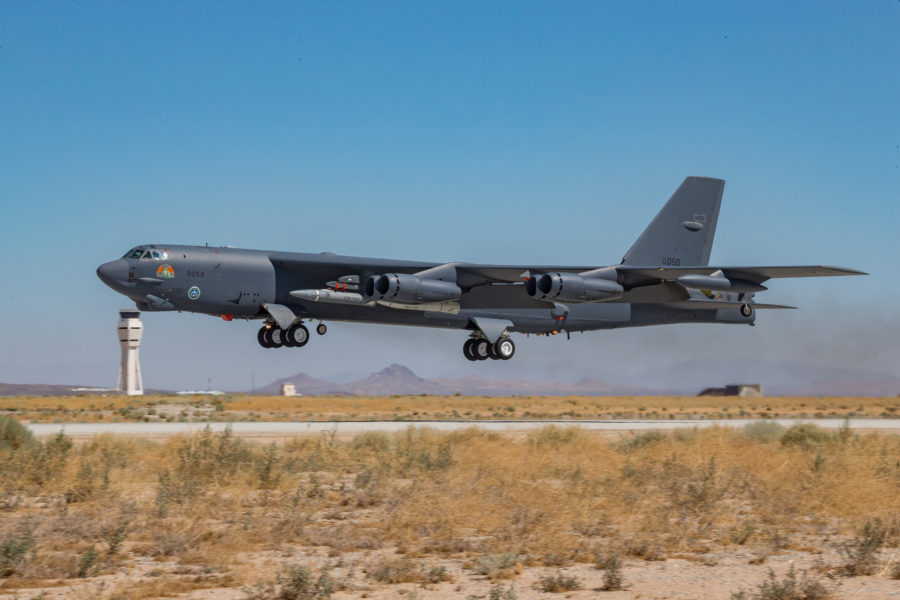The unit cost of a missile “similar to” the Air Force’s AGM-183 Air-Launched Rapid Response Weapon (ARRW) hypersonic missile would be about $15 million a copy over a large production run, but a comparable Army ground-launched system would cost almost three times more, according to a new report from the Congressional Budget Office.
In “U.S. Hypersonic Weapons and Alternatives,” the CBO said that a program “similar to” ARRW—which has now reached the phase of testing an all-up operational round—would cost $14.9 million each over a run of 300 missiles. Adding in platform integration and 20 years of sustainment, CBO estimates a program cost of $5.3 billion, not including development. The CBO used “similar to” because actual performance and costs are classified.
To reach its estimates, the CBO said it used the Army ATACMS missile, comparable to the ARRW in size and complexity, as a basis. It said it relied on “publicly available data” and no classified information in developing its estimates.
If only 100 ARRW-like missiles are bought, the unit cost would be $18 million a copy, and with sustainment and integration, the program cost would be $2.2 billion.
The CBO estimates the ARRW, which it describes as a “medium range” hypersonic missile, would have a reach of 1,000 kilometers, or about 620 miles, and travel at an average speed of Mach 7. The ARRW is a product of Lockheed Martin’s Missiles and Fire Control unit, with heavy input from the Skunk Works advanced development products division.
However, an Army system “similar” to its Long-Range Hypersonic Weapon—like ARRW, a boost-glide hypersonic missile, but with longer range—would cost $41 million per round across a production run of 300 missiles, and with platform integration and 20 years of sustainment, would cost $17.9 billion for the program.
The LRHW, built by Lockheed Martin and Northrop Grumman, would have a range of about 3,000 kilometers, or 1,860 miles, and travel at a speed of about Mach 10, the CBO said.
The CBO did not estimate comparable unit costs for the Air Force’s Hypersonic Attack Cruise Missile, which will be an air-breathing, scramjet-powered air-launched missile. The HACM contract was awarded to Raytheon and Northrop last September, and the CBO said the program is not yet mature enough to make meaningful cost estimates.

While the ARRW is intended to be carried by the B-52 and possibly the B-1 bombers, the HACM is meant to be carried by fighter-sized aircraft.
An inventory of 300 ARRWs, “would allow for more than 65 B-52 missions with four missiles each,” the CBO noted.
The comparison between the Air Force and Army programs is relevant because Army leaders have in recent years said the service is ready to share in—if not take over—the deep-strike mission using hypersonic weapons. Deep strike has traditionally—under the Key West agreements dividing roles and missions of the services—been an Air Force responsibility with long-range bombers.
The CBO report contrasted the fact that Army hypersonic missiles need a safe ground launch site, while Air Force bombers can launch from an unpredictable position, although the Air Force would have to launch the ARRW closer to the intended target.
The CBO listed the costs and capabilities for various combinations of hypersonic weapons in order to provide Congress with context for making choices about which weapons to fund in coming budget deliberations.
In comparison to hypersonic weapons, the cost of the AGM-158 Joint Air-to-Surface Standoff Missile—Extended Range (JASSM-ER)—a stealthy missile with a range of 1,000 km that travels at a far slower speed, is about $1.4 million per round.
Despite the high cost per shot of hypersonic missiles, the CBO said there may be military value in being able to strike extremely high-value targets from thousands of miles away with a flight time of only 15-30 minutes. Such strikes could also be useful in the early stages of a conflict.
Compared to ballistic missiles with maneuvering warheads, hypersonic weapons would also enjoy somewhat better survivability, because ballistic missiles have a more predictable trajectory while hypersonic missiles can maneuver throughout their flight through the atmosphere.
However, there are substantial technological challenges still to overcome before hypersonic missiles are deployable, the CBO noted. The “fundamental” remaining challenge is “managing the extreme heat that hypersonic missiles are exposed to by traveling at high speeds through the atmosphere.” Surface temperatures of 3,000 degrees Fahrenheit requires “shielding hypersonic missiles’ sensitive electronics, understanding how various metals perform, and predicting aerodynamics” at such high temperatures.
Since 2019, the Pentagon has spent more than $8 billion on hypersonic missiles, the CBO said, and the Defense Department plans to spend another $13 billion on the technology across the fiscal 2023-2027 future years defense plan, with yet another $2 billion earmarked for production of Army and Air Force weapons, as “the Navy has not yet requested procurement funding for the hypersonic missile it is developing.”
